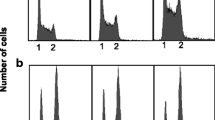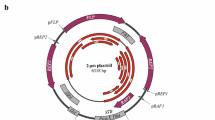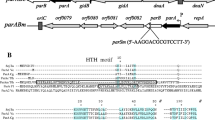Summary
Replication of plasmid R1162 DNA does not require the product of the dnaA gene. An integrated copy of the plasmid can suppress the temperature-sensitive dnaA46 allele when (1) additional plasmid copies are present in the cytoplasm and (2) an inactive replication origin, generated by deletion, is also present in the chromosome. We propose that the inactive origin sets the rate of initiation of chromosome replication at a level compatible with cell viability, possibly by providing additional binding sites for an R1162-encoded protein that is rate-limiting for plasmid replication.
Similar content being viewed by others
References
Barth PT, Grinter NJ (1974) Comparison of the deoxyribonucleic acid molecular weights and homologies of plasmids conferring linked resistance to streptomycin and sulfonamides. J Bacteriol 120:618–630
Benson S, Shapiro J (1978) TOL is a broad host-range plasmid. J Bacteriol 135:278–280
Berg D, Jorgensen R, Davies J (1978) Transposable kanamycinneomycin resistance determinants. In: Schlessinger D (ed) Microbiology —1978. ASM Publications, Washington DC, pp 13–15
Blinkowa A, Walker JR (1983) Interactions of DNA replication factors in vivo as detected by introduction of suppressor alleles of dnaA into other temperature-sensitive dna mutants. J Bacteriol 153:535–538
Bolivar F, Rodriguez RL, Greene PJ, Betlach MC, Heyneker HL, Boyer HW, Crosa JH, Falkow S (1977) Construction and characterization of amplifiable multicopy DNA cloning vehicles II. A multiple cloning system. Gene 2:95–113
Burkardt H, Riess G, Puhler A (1979) Relationship of group P1 plasmids revealed by heteroduplex experiments — RP1, RP4, R68 and RK2 are identical. J Gen Microbiol 114:341–348
Cohen SN, Chang ACY, Hsu L (1972) Nonchromosomal antibiotic resistance in bacteria: genetic transformation of Escherichia coli by R factor DNA. Proc Natl Acad Sci USA 69:2110–2114
Csonka L, Clark AJ (1980) Construction of an Hfr strain useful for transferring recA mutations between Escherichia coli strains. J Bacteriol 143:529–530
Figurski D, Meyer R, Miller D, Helinski DR (1976) Generation in vitro of deletions in the broad host range plasmid RK2 using phage Mu insertions and a restriction endonuclease. Gene 1:107–119
Friedman DI, Yarmolinsky MB (1972) Prevention of the lethality of induced λ prophage by an isogenic λ plasmid. Virology 50:472–481
Gaylo PJ, Turjman N, Bastia D (1987) DnaA protein is required for replication of the minimal replicon of the broad host-range plasmid RK2 in Escherichia coli. J Bacteriol 169:4703–4709
Hansen EB, Yarmolinsky MB (1986) Host participation in plasmid maintenance: dependence upon dnaA of replicons derived from P1 and F. Proc Natl Acad Sci USA 83:4423–4427
Haring V, Scholz P, Scherzinger E, Frey J, Derbyshire K, Hatfull G, Willetts N, Bagdasarian M (1985) Protein RepC is involved in copy number control of the broad host range plasmid RSF1010. Proc Natl Acad Sci USA 82:6090–6094
Hershfield V, Boyer HW, Yanofsky C, Lovett MA, Helinski DR (1974) Plasmid ColE1 as a molecular vehicle for cloning and amplification of DNA. Proc Natl Acad Sci USA 71:3455–3459
Hirota Y, Mordoh J, Jacob F (1970) On the process of cellular division in Escherichia coli: thermosensitive mutants of Escherichia coli altered in the process of DNA replication. J Mol Biol 53:369–387
Holmes DS, Quigley M (1981) A rapid boiling method for the preparation of bacterial plasmids. Anal Biochem 114:193–197
Jobanputra RS, Datta N (1974) Trimethoprim R factors in enterobacteria from clinical specimens. J Med Microbiol 7:169–177
Kim K, Meyer RJ (1984) Novel system for recognizing and eliminating foreign DNA in Pseudomonas putida. J Bacteriol 159:678–682
Koppes L, Nordstrom K (1986) Insertion of an R1 plasmid into the origin of replication of the E. coli chromosome: random timing of replication of the hybrid chromosome. Cell 44:117–124
Lin L-S, Meyer RJ (1984) Nucleotide sequence and functional properties of DNA encoding incompatibility in the broad hostrange plasmid R1162. Mol Gen Genet 194:423–431
Lin L-S, Meyer RJ (1986) Directly repeated, 20-bp sequence of plasmid R1162 DNA is required for replication, expression of incompatibility, and copy-number control. Plasmid 15:35–47
Lin L-S, Meyer RJ (1987) DNA synthesis is initiated at two positions within the origin of replication of plasmid R1162. Nucleic Acids Res 15:8319–8331
Lin L-S, Kim Y-J, Meyer RJ (1987) The 20 bp, directly repeated DNA sequence of broad host-range plasmid R1162 exerts incompatibility in vivo and inhibits R1162 DNA replication in vitro. mol Gen Genet 208:390–397
Messing J, Crea R, Seeburg PH (1981) A system for shotgun DNA sequencing. Nucleic Acids Res 9:309–321
Meyer R, Figurski D, Helinski DR (1977) Physical and genetic studies with restriction endonucleases on the brod host-range plasmid RK2. Mol Gen Genet 152:129–135
Meyer R, Hinds M, Brasch M (1982) Properties of R1162, a broad host-range, high copy-number plasmid. J Bacteriol 150:552–562
Meyer RJ, Lin LS, Kim K, Brasch MA (1985) Braod host-range plasmid R1162: replication, incompatibility and copy-number control. In: Helinski DR, Cohen SN, Clewell DB, Jackson DA, Hollaender A (eds) Plasmids in bacteria. Plenum, New York London, pp 173–188
Miller J (1972) Experiments in molecular genetics. Cold Spring Harbor Laboratory Press, Cold Spring Harbor, New York
Pinkney M, Thomas CM (1987) Replication and maintenance of promiscuous plasmids of Gram-negative bacteria. Microbiol Sci 4:186–191
Sanger F, Nicklen S, Coulson A (1977) DNA sequencing with chain-terminating inhibitors. Proc Natl Acad Sci USA 74:5463–5467
Scholz P, Haring V, Scherzinger E, Lurz R, Bagdasarian MM, Schuster H, Bagdasarian M (1985) Replication determinants of the broad host-range plasmid RSF1010. In: Helinski DR, Cohen SN, Clewell DB, Jackson DA, Hollaender A (eds) Plasmids in bacteria. Plenum, New York London, pp 243–259
Shaw KJ, Berg CM (1979) Escherichia coli K12 auxotrophs induced by insertion of the transposable element Tn5. Genetics 92:741–747
Thomas CM, Meyer R, Helinski DR (1980) Regions of broad-hostrange plasmid RK2 which are essential for replication and maintenance. J Bacteriol 141:213–222
Yamaguchi K, Tomizawa J-I (1980) Establishment of Escherichia coli cells with an integrated high copy number plasmid. Mol Gen Genet 178:525–533
Author information
Authors and Affiliations
Additional information
Communicated by N.D.F. Grindley
Rights and permissions
About this article
Cite this article
Brasch, M.A., Meyer, R.J. Integrative suppression of dnaA46 by broad host-range plasmid R1162. Mol Gen Genet 215, 139–145 (1988). https://doi.org/10.1007/BF00331315
Received:
Issue Date:
DOI: https://doi.org/10.1007/BF00331315




